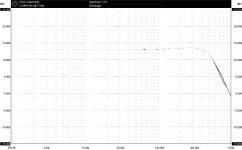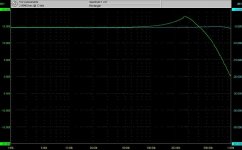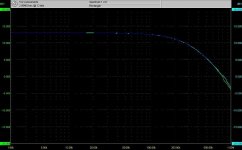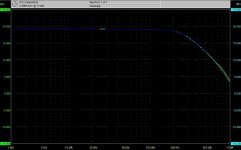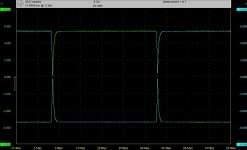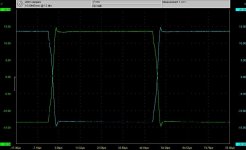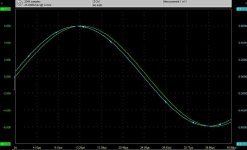I am posting a general question and am hoping for some constructive ideas.
In the few Class-A power amps that I have built, typically an Aleph-X, the closed loop frequency response always seems to have a hump before the -6dB decay, indicating inductivity somewhere.
Of course one can damp this down by increasing the value of the capacitor across the feedback resistor.
But I wonder where the inductivity comes from and how it may be removed.
The frequency response as shown is with a speaker as load, but it does not change much even if the speaker is removed and replace with say a 100 ohm power resistor.
It also changes little even if one increases the values of the gate resistor of the output FETs.
Any comments as to what the root cause of the hump might be ?
Thanks,
Patrick
In the few Class-A power amps that I have built, typically an Aleph-X, the closed loop frequency response always seems to have a hump before the -6dB decay, indicating inductivity somewhere.
Of course one can damp this down by increasing the value of the capacitor across the feedback resistor.
But I wonder where the inductivity comes from and how it may be removed.
The frequency response as shown is with a speaker as load, but it does not change much even if the speaker is removed and replace with say a 100 ohm power resistor.
It also changes little even if one increases the values of the gate resistor of the output FETs.
Any comments as to what the root cause of the hump might be ?
Thanks,
Patrick
Attachments
While I take your point about phase margin, I am not sure whether I agree entirely that it has nothing to do with inductivity.
You can have too small phase margin and hence instability even without that hump. But the hump indicates excessive gain at high frequencies. In fact, if you take out the feedback cap entirely, the hump would be more prominent.
My question was not how to suppress that hump. One can just increase the feedbacl cap. Rather, I wonder what causes the hump in the first place, and whether it can be removed without adding a feedback cap. Feedback cap is the easy way out.
Patrick
You can have too small phase margin and hence instability even without that hump. But the hump indicates excessive gain at high frequencies. In fact, if you take out the feedback cap entirely, the hump would be more prominent.
My question was not how to suppress that hump. One can just increase the feedbacl cap. Rather, I wonder what causes the hump in the first place, and whether it can be removed without adding a feedback cap. Feedback cap is the easy way out.
Patrick
The hump means that you have a higher Q value to the rolloff
than you probably want, meaning there are at least 2 poles
of rolloff operating before you reach the unity gain point at high
frequencies.
There is nothing technically wrong with this, but as a rule we
like to remove it for sonic or at least aesthetic reasons. You
can do this by lowering the frequency of one of these poles
(that is to say, slow down some portion of the circuit) or by
raising the frequency of one of the poles (speeding up some
part of the circuit).
Usually we just trim the feedback cap, and that works fine.
I should add the a 500 KHz rolloff is quite fast, so you have
some bandwidth to burn IMHO.

than you probably want, meaning there are at least 2 poles
of rolloff operating before you reach the unity gain point at high
frequencies.
There is nothing technically wrong with this, but as a rule we
like to remove it for sonic or at least aesthetic reasons. You
can do this by lowering the frequency of one of these poles
(that is to say, slow down some portion of the circuit) or by
raising the frequency of one of the poles (speeding up some
part of the circuit).
Usually we just trim the feedback cap, and that works fine.
I should add the a 500 KHz rolloff is quite fast, so you have
some bandwidth to burn IMHO.
Thank for the advice. I shall look into it further.
I have tried the feedback cap route and ended up with 300kHz -3dB. Still very fast, but I take it as a challenge to cure the hump rather than correct for it with the feedback loop.
Pending further investigation. : )
Patrick
I have tried the feedback cap route and ended up with 300kHz -3dB. Still very fast, but I take it as a challenge to cure the hump rather than correct for it with the feedback loop.
Pending further investigation. : )
Patrick
William,
It is a general problem not specific to Aleph-X.
For example, my Xed Lindsley Hood MOSFET has a similar response, and it uses a phase splitter to drive the output FETs instead of the Aleph Current Multiplier.
Of course the phase splitter also has its own bandwidth, phase shifts, etc.
Patrick
It is a general problem not specific to Aleph-X.
For example, my Xed Lindsley Hood MOSFET has a similar response, and it uses a phase splitter to drive the output FETs instead of the Aleph Current Multiplier.
Of course the phase splitter also has its own bandwidth, phase shifts, etc.
Patrick
EUVL said:[snip] But the hump indicates excessive gain at high frequencies. In fact, if you take out the feedback cap entirely, the hump would be more prominent.[snip]Patrick
Another way to say this is that you have still a lot of gain when the phaseshift increases. Such a case means that the negative feedback tends to change to positive feedback which means increase of gain rather than decrease. As Nelson pointed out, you can decrease the phase shift, or increase the gain roll-of with frequency to get rid of it. Problem is often that these things are coupled, for instance if you increase the gain roll-off with a cap you probably at the same time increase phase shift so it doesn't get you very far.
Or you can increase the closed loop gain (less feedback).
Jan Didden
Jan,
I already don't have much feedback, only 30dB or so.
And this hump only appears at one side of the X amp output relative to ground when driven by a single ended (not balanced) input. The other side has flat response to roll off -3dB at 1.5MHz, as I have expected. So I do not understand it fully yet.
I am going to drive the thing with balanced inputs in the next days and see what happens. It may be that I have too much common mode current going from the outputs to ground. But I only thought of this last night, and haven't had time to verify yet.
Patrick
I already don't have much feedback, only 30dB or so.
And this hump only appears at one side of the X amp output relative to ground when driven by a single ended (not balanced) input. The other side has flat response to roll off -3dB at 1.5MHz, as I have expected. So I do not understand it fully yet.
I am going to drive the thing with balanced inputs in the next days and see what happens. It may be that I have too much common mode current going from the outputs to ground. But I only thought of this last night, and haven't had time to verify yet.
Patrick
If the Sources of the Diff pair are connected to finite impedances
in addition to the "perfect" current source which biases them,
then you will see some variation driven single ended. If you
are using the "magic resistors" to control the common mode DC
offset on an X amp, you should consider increasing their value.

in addition to the "perfect" current source which biases them,
then you will see some variation driven single ended. If you
are using the "magic resistors" to control the common mode DC
offset on an X amp, you should consider increasing their value.
I am using 2SJ109BL for the diff pair, ZVP4424A cascoded at -7V, current source is 2SJ74BL @ 8mA, cascoded by J174 @ -5V. Source resistors are 10 ohm, drain resistors 910 ohm. Magic resistors 10k.
I have tried doubling the gate resistors (from 432R to 1k) but it does not improve things. Currently the feedback cap needs to be 10p // 50k to get rid of the hump. Small signal square wave is then fine. Large signal (+/- 12V Vout) square wave has a small spike, which I found surprising. Load was the Stereophile dummy speaker (4ohm reactive load). This is now with balanced input from a DRV134. I have measured the freq response of the chip, flat to 1MHz, though square waves have tiny spikes. The frequency response in post #1 was measured using sweep sines.
I need to tidy up the measurement screen shots first before posting.
Thanks for the hints so far,
Patrick
I have tried doubling the gate resistors (from 432R to 1k) but it does not improve things. Currently the feedback cap needs to be 10p // 50k to get rid of the hump. Small signal square wave is then fine. Large signal (+/- 12V Vout) square wave has a small spike, which I found surprising. Load was the Stereophile dummy speaker (4ohm reactive load). This is now with balanced input from a DRV134. I have measured the freq response of the chip, flat to 1MHz, though square waves have tiny spikes. The frequency response in post #1 was measured using sweep sines.
I need to tidy up the measurement screen shots first before posting.
Thanks for the hints so far,
Patrick
I hope I have sorted all measurement bugs out including differential probe bandwidths, etc., so here are the results driven by balanced signals.
Frequency response with 2p feedback cap, balanced sine input 0.5V, dummy speaker load.
Green is +Vout to Gnd, Cyan is +Vin to Gnd.
Negative side is now identical.
Frequency response with 2p feedback cap, balanced sine input 0.5V, dummy speaker load.
Green is +Vout to Gnd, Cyan is +Vin to Gnd.
Negative side is now identical.
Attachments
EUVL said:20kHz sine wave showing input / output phase shifts
Patrick,
I think you are seeing problems that aren't really problems. +3dB @ 200kHz, so what?
Do you have an input low-pass filter on that amp? You should have one to keep out anything that isn't audio. Like -3dB @ 50kHz? I bet your hump thing will be gone then anyway.
Jan Didden
- Status
- This old topic is closed. If you want to reopen this topic, contact a moderator using the "Report Post" button.
- Home
- Amplifiers
- Pass Labs
- Hump in Closed Loop Frequency Response -- Root Cause ?
